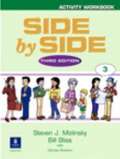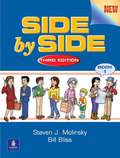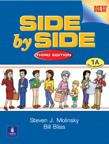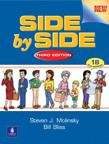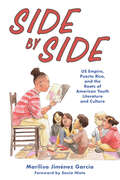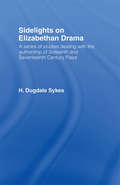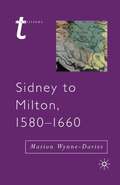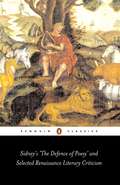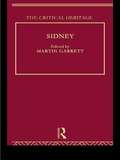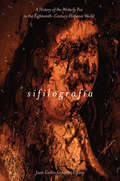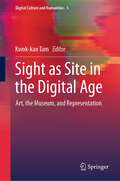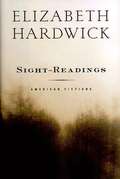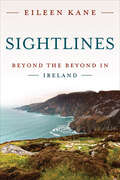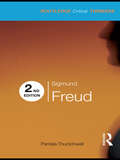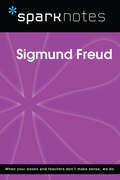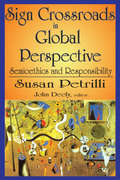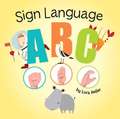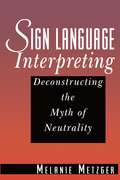- Table View
- List View
Side by Side Activity Workbook, Book 3 (3rd Edition)
by Steven J. Molinsky Bill BlissThe Side by Side Activity Workbooks offer a variety of exercises for reinforcement, fully coordinated with the student texts. A special feature of the Activity Workbooks is the inclusion of GrammarRaps for practice with rhythm, stress, and intonation and GrammarSongs from the Side by Side TV videos. Periodic check-up tests are also included in the workbooks. Side by Side Plus is a standards-based and grammar-based English language program for adult and young-adult learners, The program builds students' general language proficiency and prepares them for their life-skill roles in the community, family, school, and at work.
Side by Side Book 1
by Steven J. Molinsky Bill BlissSide by Side, Third Edition, by Steven J. Molinsky and Bill Bliss, is a dynamic, all-skills program that integrates conversation practice, reading, writing, and listening -- all in a light-hearted, fun, and easy-to-use format that has been embraced by students and teachers worldwide. This four-level program promotes native communication between students ... practicing speaking together "side by side."
Side by Side Book 1A
by Steven J. Molinsky Bill BlissSide by Side, Third Edition, is the new and improved version of this dynamic, all skills program that integrates grammar and functions in a conversational approach all in a light-hearted, fun, and easy-to-use format that has been embraced by students and teachers worldwide.
Side by Side Book 1B
by Steven J. Molinsky Bill BlissSide by Side, Third Edition, is the new and improved version of this dynamic, all skills program that integrates grammar and functions in a conversational approach all in a light-hearted, fun, and easy-to-use format that has been embraced by students and teachers worldwide.
Side by Side: US Empire, Puerto Rico, and the Roots of American Youth Literature and Culture (Children's Literature Association Series)
by Marilisa Jiménez GarcíaWinner of the Children’s Literature Association’s 2023 Book AwardDuring the early colonial encounter, children’s books were among the first kinds of literature produced by US writers introducing the new colony, its people, and the US’s role as a twentieth-century colonial power to the public. Subsequently, youth literature and media were important tools of Puerto Rican cultural and educational elite institutions and Puerto Rican revolutionary thought as a means of negotiating US assimilation and upholding a strong Latin American, Caribbean national stance. In Side by Side: US Empire, Puerto Rico, and the Roots of American Youth Literature and Culture, author Marilisa Jiménez García focuses on the contributions of the Puerto Rican community to American youth, approaching Latinx literature as a transnational space that provides a critical lens for examining the lingering consequences of US and Spanish colonialism for US communities of color. Through analysis of texts typically outside traditional Latinx or literary studies such as young adult literature, textbooks, television programming, comics, music, curriculum, and youth movements, Side by Side represents the only comprehensive study of the contributions of Puerto Ricans to American youth literature and culture, as well as the only comprehensive study into the role of youth literature and culture in Puerto Rican literature and thought. Considering recent debates over diversity in children’s and young adult literature and media and the strained relationship between Puerto Rico and the US, Jiménez García's timely work encourages us to question who constitutes the expert and to resist the homogenization of Latinxs, as well as other marginalized communities, that has led to the erasure of writers, scholars, and artists.
Sidelights on Elizabethan Drama
by H.D. SykesFirst Published in 1966. Routledge is an imprint of Taylor & Francis, an informa company.
Sidney to Milton, 1580–1660 (Transitions Ser.)
by Marion Wynne-DaviesThis invaluable guide offers readers an accessible and imaginative approach to the literature of early modern Britain. Exploring the poetry, drama and prose of the period, Marion Wynne-Davies combines theory and practice, providing a helpful introduction to key theoretical concepts and close readings of individual texts by both canonical and less well-known authors. Amongst other things, Wynne-Davies discusses sixteenth- and seventeenth-century poetry in its political and cultural contexts, considers Renaissance drama in terms of performance space, and uses the early modern map to explain the prose works of writers such as Bunyan and Cavendish.
Sidney's 'The Defence of Poesy' and Selected Renaissance Literary Criticism
by Gavin AlexanderControversy raged through England during the 1570-80s as Puritans denounced all manner of games & pastimes as a danger to public morals. Writers quickly turrned their attention to their own art and the first & most influential response came with Philip Sidney's Defense. Here he set out to answer contemporary critics &, with reference to Classical models of criticism, formulated a manifesto for English literature. Also includes George Puttenham's Art of English Poesy, Samuel Daniel's Defence of Rhyme, & passages by writers such as Ben Jonson, Francis Bacon & George Gascoigne.
Sidney: The Critical Heritage (Critical Heritage Ser.)
by Martin GarrettFirst published in 1996. Routledge is an imprint of Taylor & Francis, an informa company.
Siegfried Sassoon: The Making of a War Poet, A Biography (1886-1918)
by Jean Moorcroft WilsonThis book encompasses the complete life and works of Siegfried Sassoon, from his patriotic youth that led him to the frontline, to the formation of his anti-war convictions, great literary friendships and flamboyant love affairs.
Siegfried Sassoon: The Making of a War Poet, A biography (1886-1918)
by Jean Moorcroft WilsonThis book encompasses the complete life and works of Siegfried Sassoon, from his patriotic youth that led him to the frontline, to the formation of his anti-war convictions, great literary friendships and flamboyant love affairs.
Siete ensayos sobre la peste
by Carlos GamerroLa primera historia cultural de la peste: un recorrido erudito y reflexivo por epidemias y pandemias en la literatura y las artes, de la mano de Carlos Gamerro, uno de los novelistas y ensayistas más prestigiosos de la actualidad. Uno de los propósitos de estos ensayos sobre la peste es entendernos mejor: la vivencia de las epidemias y pandemias acompañó a la humanidad desde siempre; conocer su expresión en la literatura y las artes sirve para tener una imagen más acabada de nosotros mismos. El recorrido por la historia de las epidemias y pandemias en la literatura y las artes -desde la Ilíada hasta las películas de muertos vivos- que Carlos Gamerro propone en este libro interpela persistente nuestros tiempo y experiencia contemporáneos. Aquí se exploran orígenes e ideas, fantasías y decisiones políticas derivadas de la consideración de la peste como castigo divino, daño de brujas, guerra o conspiración. Al mismo tiempo se releen las condiciones de posibilidad del surgimiento del Diario del año de la peste de Daniel Defoe, la influencia de la costumbre de usar a la peste como metáfora de otras calamidades, como la guerra y la ocupación en La peste de Albert Camus, o los goces prohibidos que habilita en el Decamerón de Boccaccio, Muerte en Venecia o El amor en los tiempos del cólera. Fruto de una de las voces más potentes y originales en la novela y el ensayo argentinos contemporáneos, esta obra exquisita por lo erudita e iluminadora por lo reflexiva y original se erige en verdadera historia cultural de la peste, y en ese gesto deja ver su vocación de clásico.
Sifilografía: A History of the Writerly Pox in the Eighteenth-Century Hispanic World (Writing the Early Americas)
by Juan Carlos González EspitiaSyphilis was a prevalent affliction in the era of the Americas’ colonization, creating widespread anxiety that is indicated in the period’s literature across numerous fields. Reflecting Spaniards’ political prejudices of the period, it was alternately labeled "mal francés" or "el mal de las Indias." Sifilografía offers a cultural history that traces syphilis and its consequences in the transatlantic Spanish-speaking world throughout the long eighteenth century. Juan Carlos González Espitia charts interrelated literary, artistic, medical, and governmental discourses, exploring how fears of the disease and the search for its cure mobilized a transoceanic dialogue that forms an underside of Enlightenment narratives of progress.Through a narrative revealing the transformation and retooling of ideas related to syphilis as a bodily contagion, González Espitia demonstrates the Spanish-speaking world’s crucial relevance to a global understanding of the period in the context of current reassessments of Enlightenment thought. Broad in its scope, the book incorporates an extensive corpus of medical treatises, literary essays, poems, novels, art, and governmental documents. The rich overlapping matrix of authors and texts broached subvert the idea of a homogeneous interpretation of syphilis and contributes to the rediscovery of the wide-ranging historical, cultural, and philosophical impact of this disease in the Spanish-speaking world. Sifilografía seeks to open a productive dialogue with other area studies about the disparate meanings of science and Enlightenment.
Sight as Site in the Digital Age: Art, the Museum, and Representation (Digital Culture and Humanities #5)
by Kwok-Kan TamThis volume presents a broad coverage of theoretical issues that deal with digital culture, representation and ideology in art and museums, and other cultural sites, offering new insights into issues of representation in the digitization of art. It critically examines the roles of museum and archives in the digital age and reexamines the intricate relations between sight and site in art, museums, exhibitions, theme parks, theatre performances, music videos, and films. The collection represents a multidisciplinary approach to the complex issues underlying the advent of technologies and digital culture. The rise of visual culture since the twentieth century can be accounted for by the advent of technology in film, TV, museum exhibitions, and the wide use of websites, but it can also be understood as a paradigmatic shift toward representation as a visual means to interpret culture, with new understandings of the site-sight dilemma and the co-implications in related tensions. Complicating the issue of representation is the rise of digital culture, as digital sites replace actual physical sites. This book explores how the virtual has replaced the actual, and in what ways, and to what effects, the digital has displaced the physical. With contributions by museum curators, communications scholars, visual artists, theatre artists, filmmakers, literary critics, and historians, this volume is of appeal to academics and graduate students in information science, art, media, performance, literary and cultural studies, and history. “The book binds together different concepts such as site, sight and digitalization in a very original way. It convincingly gathers contributions from academics and practitioners, artists and museum specialists. The chapters are theoretically well-founded, show an interesting breadth of content and are also dealing with current developments.”— Monika Gänssbauer, Professor of Chinese and Head of the Institute of Asian, Middle Eastern and Turkish Studies, Stockholm University, Sweden “The chapters raise important and latest questions and discussions on the impact of digital technology has on art, culture, creativity, representation and innovation. They are original in dealing with latest examples in recent years, especially during the pandemic, with reflections and philosophical discussions on the transformation digital culture undergoes in relation to human and posthuman contexts, with examinations of art works, archives and museum collections, exhibitions, theme parks, theatre performances, films and music videos that encompass cultures from ancient to contemporary, from the West to the East, and from physical to digital.”— Jack Leong, Associate Dean of Research and Open Scholarship, York University Libraries, Toronto, Canada
Sight-Readings: American Fictions
by Elizabeth HardwickIt is only in a country where newness and change and brevity of tenure are the common substance of life," wrote Henry James, "that the fact of one's ancestors having lived for a hundred and seventy years in a single spot would become an element of one's morality." Newness and rootedness are the twin poles of Sight-Readings, Elizabeth Hardwick's brilliant new collection of essays. (Her first, Seduction and Betrayal, was nominated for the National Book Award.) Hardwick's focus here is on American writers, at home and abroad, and especially women, as writers and as characters: Edith Wharton, Djuna Barnes, Gertrude Stein, Mary McCarthy, Elizabeth Bishop, Katherine Anne Porter, and Joan Didion, among others. In sections on Old New York, Americans Abroad, and Fictions of America, Hardwick considers writers and their landscapes, real and imagined. Her essays on Edith Wharton and Henry James illuminate aspects of their inventions of New York. From there she takes us to the Paris of Gertrude Stein and Djuna Barnes, into the hermetic world of Boston Transcendentalism, and on to the suburbs of John Cheever, the America of Philip Roth and John Updike, and the restless expanses of Richard Ford and the Prairie poets. Elizabeth Hardwick has achieved a permanent place in American letters for her sharp and elegant criticism. Her essays on American writers are themselves a work of literature.
Sightlines: Beyond the Beyond in Ireland
by Eileen KaneIt is the 1960s, and Ireland is hoping to join what will later become the European Union. The government has devised a plan to stem emigration and save the Irish language by supporting small factories in the Gaeltacht, traditional Irish-speaking villages in remote western areas. But is the plan working? With her signature humor and charm, Eileen Kane transports the reader to County Donegal with a detailed account of rural Irish life during this period of rapid change. This is a story about people living beyond the margins of maps, boundaries, language groups, and government departments – people bound by borders that have little or no correspondence to their own cultural, economic, and historical margins. Ultimately, it is a story about life on the edges, and the places and people who fall outside them.
Sigmund Freud (Routledge Critical Thinkers)
by Pamela ThurschwellThe work of Sigmund Freud has penetrated almost every area of literary theory and cultural studies, as well as contemporary culture. Pamela Thurschwell explains and contextualises psychoanalytic theory and its meaning for modern thinking. This updated second edition explores developments and responses to Freud’s work, including: tracing contexts and developments of Freud’s work over the course of his career exploring paradoxes and contradictions in his writing focusing on psychoanalysis as an interpretative strategy, paying special attention to its impact on literary and cultural theory examining the recent backlash against Freud and arguing for the continued relevance of psychoanalysis. Encouraging and preparing readers to approach Freud’s original texts, this guide ensures that readers of all levels will find Freud accessible, challenging and of continued relevance.
Sigmund Freud (SparkNotes Biography Guide)
by SparkNotesSigmund Freud (SparkNotes Biography Guide) Making the reading experience fun! SparkNotes Biography Guides examine the lives of historical luminaries, from Alexander the Great to Virginia Woolf. Each biography guide includes:An examination of the historical context in which the person lived A summary of the person&’s life and achievements A glossary of important terms, people, and events An in-depth look at the key epochs in the person&’s career Study questions and essay topics A review test Suggestions for further reading Whether you&’re a student of history or just a student cramming for a history exam, SparkNotes Biography guides are a reliable, thorough, and readable resource.
Sign Crossroads in Global Perspective: Semiotics and Responsibilities
by Susan PetrilliLanguage is the species-specific human version of the animal system of communication. In contrast to non-human animals, language enables humans to invent a plurality of possible worlds; reflect upon signs; be responsible for our actions; gain conscious awareness of our inevitable mutual involvement in the network of life on this planet; and be responsibly involved in the destiny of the planet. The author looks at semiotics, the study of signs, symbols, and communication as developing sequentially rather than successively, more synchronically than diachronically. She discusses the contemporary phenomenon that people in today's society have witnessed and participated in, as part of the development of semiotics. Although there is a long history preceding semiotics, in a sense the field is, as a phenomenon, more "of our time" than of any time past. Its leading figures, whom Petrilli examines, belong to the twentieth and twenty-first century. Semiotics is associated with a capacity for listening. This capacity is also the condition for reconnecting to and recovering the ancient vocation of semiotics as that branch of medical science relating to the interpretation of signs or symptoms. The pragmatic aspect of global semiotics studies the impact of language or signs on those who use them, and looks for consequences in actual practice. In this respect, Petrilli theorizes that the task for semiotics in the era of globalization is nothing less than to take responsibility for life in its totality.
Sign Language ABC
by Lora HellerBold and bright, hip and cool, this striking ABC book is like none other: each page teaches children the American Sign Language alphabet through a combination of letters, hand spelling, and adorable illustrations.
Sign Language Brokering in Deaf-Hearing Families
by Jemina NapierThis book details a study of sign language brokering that is carried out by deaf and hearing people who grow up using sign language at home with deaf parents, known as heritage signers. Child language brokering (CLB) is a form of interpreting carried out informally by children, typically for migrant families. The study of sign language brokering has been largely absent from the emerging body of CLB literature. The book gives an overview of the international, multi-stage, mixed-method study employing an online survey, semi-structured interviews and visual methods, to explore the lived experiences of deaf parents and heritage signers. It will be of interest to practitioners and academics working with signing deaf communities and those who wish to pursue professional practice with deaf communities, as well as academics and students in the fields of Applied Linguistics, Intercultural Communication, Interpreting Studies and the Social Science of Childhood.
Sign Language Interpreting: Deconstructing the Myth of Neutrality (Gallaudet Studies In Interpret Ser. #9)
by Melanie MetzgerAs with all professional interpreters, sign language interpreters strive to achieve the proper protocol of complete objectivity and accuracy in their translation without influencing the interaction in any way. Yet, Melanie Metzger's significant work Sign Language Interpreting: Deconstructing the Myth of Neutrality demonstrates clearly that the ideal of an interpreter as a neutral language conduit does not exist. Metzger offers evidence of this disparity by analyzing two videotaped ASL-English interpreted medical interviews, one an interpreter-trainee mock interview session, and the other an actual encounter between a deaf client and a medical professional. Sign Language Interpreting relies upon an interactional sociolinguistic approach to ask fundamental questions regarding interpreter neutrality. First, do interpreters influence discourse, and if so, how? Also, what kind of expectations do the participants bring to the event, and what do the interpreters bring to discussions? Finally, how do their remarks affect their alignment with participants in the interaction? Using careful assessments of how these interviews were framed, and also re-interviewing the participants for their perspectives, this penetrating book discloses the ways in which interpreters influence these situations. It also addresses the potential implications of these findings regarding sign language interpretation in medical, educational, and all other general interactions. Interpreter trainers and their students will join certified interpreters and Deaf studies scholars in applauding and benefiting from the fresh ground broken by this provocative study.
Sign Language Machine Translation (Machine Translation: Technologies and Applications #5)
by Lorraine Leeson Andy Way Dimitar ShterionovThis book, for the first time, collects important current topics in the area of sign language translation in a single volume. The topic is introduced more generally to benefit newcomers to the field before diving into the current state-of-the-art methods of Sign Language Machine Translation (SLMT), together with an in-depth description of issues specific to this topic, including: an introduction to and historical overview of SLMT; ethical issues related to the engagement of and with deaf users; the importance of data; the sign languages of Europe; sign language recognition and synthesis, including via avatars; data-driven and linguistically-informed models of SLMT; gloss translation; fingerspelling; SLMT communication; and SLMT in practice. Of interest to MT developers and users as well as people working in deaf studies, this volume presents cutting-edge research on machine translation in the field of deaf studies.
Sign Language Made Simple
by Karen LewisSign Language Made Simple will include five Parts:Part One: an introduction, how to use this book, a brief history of signing and an explanation of how signing is different from other languages, including its use of non-manual markers (the use of brow, mouth, etc in signing.)Part Two: Fingerspelling: the signing alphabet illustrated, the relationship between signing alphabet and ASL signsPart Three: Dictionary of ASL signs: concrete nouns, abstractions, verbs, describers, other parts of speech-approx. 1,000 illustrations. Will also include instructions for non-manual markers, where appropriate.Part Four: Putting it all together: sentences and transitions, includes rudimentary sentences and lines from poems, bible verses, famous quotes-all illustrated. Also, grammatical aspects, word endings, tenses.Part Five: The Humor of Signing: puns, word plays and jokes.Sign Language Made Simple will have over 1,200 illustrations, be easy to use, fun to read and more competitively priced than the competition. It's a knockout addition to the Made Simple list.
